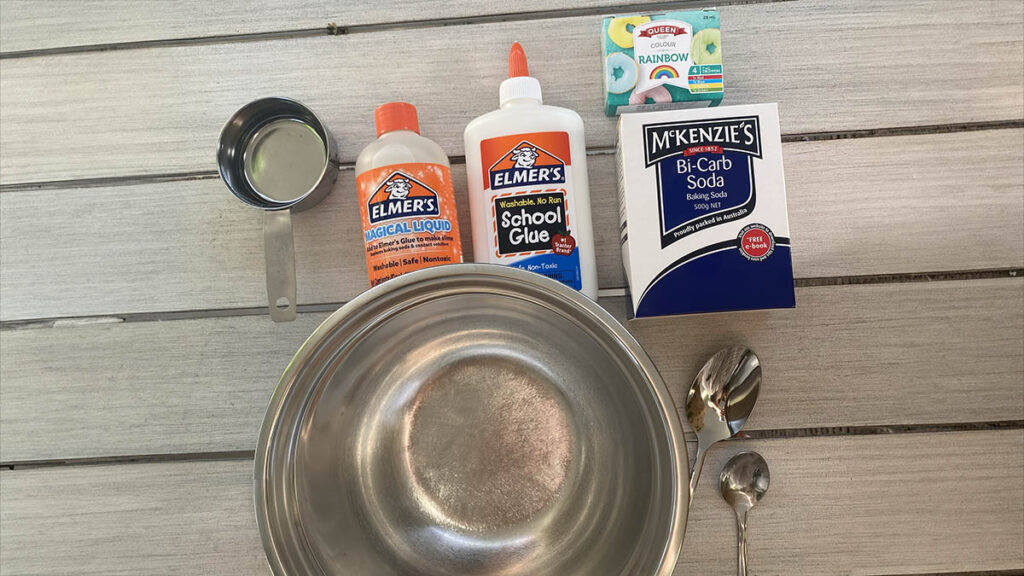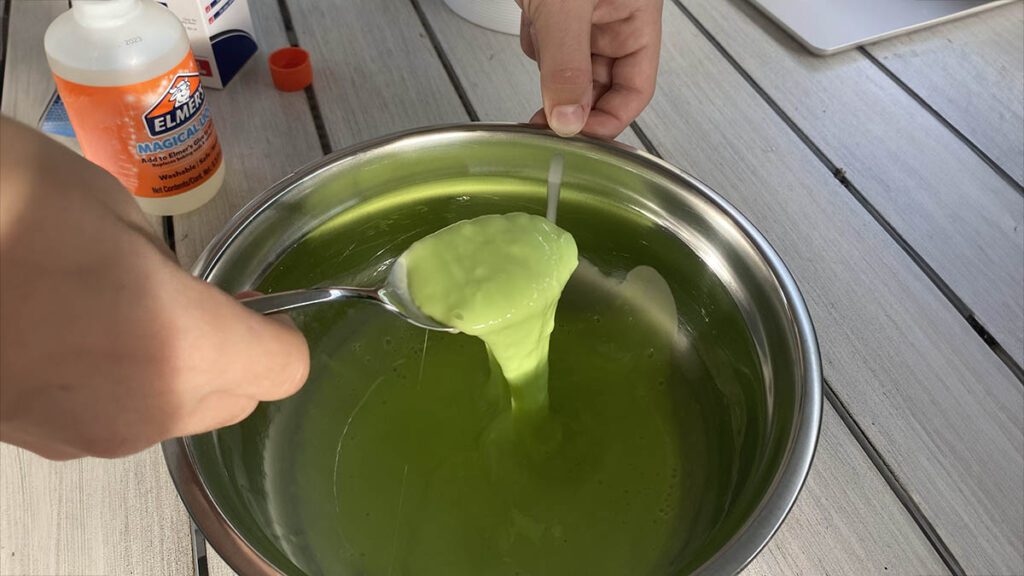Slime is captivating, fun and full of customisation possibilities. Beyond the playful aspect, making and playing with slime offers numerous educational and sensory benefits.
Buying pre-made slime from the shops can be expensive and it often just gets thrown out after a couple of plays. The kids will love creating their own with this slime recipe and you’ll find it’s way more affordable than the shop-bought ones.
Our recipe makes a large bunch of slime, enough for several kids to have a good handful to play with.
The joy of creating slime
Creating slime is an activity that combines science and creativity. The process of mixing simple ingredients to produce a stretchy, squishy substance is magical for kids. It provides hands-on fun and is a very tactile activity which is especially intriguing for younger kids.
With the limitless options of colour, glitter and other add-ins, you can spark imagination and experimentation. (Just be aware of any potential choking hazards.)
The best type of slime recipe calls for easily accessible and inexpensive ingredients, and that’s exactly what you’ll find below. It’s the perfect activity for a rainy day or a playdate.
The best slime doesn’t let you down
How often have you bought expensive ingredients like borax, contact lens solution, liquid starch and specific brands of shaving cream only to have the slime turn to a flop? Probably too many to count.
You won’t have that issue with our easy slime recipe. You won’t need borax powder, boric acid, contact solution or saline solution. All that’s required are a few common household ingredients. If you follow the simple steps using the main ingredients, you can’t go wrong.
Easy slime recipe

This homemade slime recipe with a very short ingredient list will give you ample amounts of slime and fun. It takes around five minutes to make for hours of fun.
Slime ingredients:
- ½ cup clear PVA glue or white glue (we used Elmer’s white glue)
- ½ cup water
- ¼ teaspoon bicarbonate soda (may need less if using clear glue)
- 1 tablespoon food colouring
- Optional: Add-ins of choice (such as glitter or confetti)
- Elmer’s Magical Liquid (slime activator)
Method:
- In a bowl, mix water and glue.
- Add bicarbonate soda and stir well.
- Add food colouring and add-ins, if using, and stir.
- Add 2 teaspoons of Elmer’s Magical Liquid and stir. Then keep adding 1 teaspoon of Elmer’s Magical Liquid until the slime pulls away from the bowl and no longer sticks to your hands anymore. It may take 7–8 teaspoons to get it just right. The desired consistency of slime is gooey, stretchy and doesn’t easily break apart or stick to everything.
- Keep the slime in an airtight container until it dries out or gets too dirty to play with.
Note:
The ingredients may be irritating to sensitive skin. Children should always wash their hands before and after playing with slime. Ensure all ingredients are suitable for your child before using. If there are any concerns about skin irritation, use gloves.
Educational benefits of slime-making

Making slime introduces children to lots of scientific concepts, team-building and other basic skills.
1. Fundamental concepts of chemistry
The process involves combining substances to create a new material with different properties. This activity helps children understand:
- Polymers and cross-linking: Slime is a non-Newtonian fluid formed through the cross-linking of polymers. This hands-on demonstration of chemical reactions and molecular bonding is a tangible way to grasp otherwise abstract concepts.
- States of matter: Observing the transition from liquid to a semi-solid state provides a practical understanding of states of matter and how substances can change form through chemical reactions.
2. Enhancing problem-solving skills
The process of making slime often requires experimentation and adjustment to achieve the desired consistency. This trial-and-error approach helps develop problem-solving skills as children:
- Hypothesise and test: Predict what might happen if they add more or less of a certain ingredient and then observe the results.
- Critical thinking: Analyse why the slime turned out too sticky or too hard and figure out how to correct it.
3. Sensory play and development
Slime-making is a form of sensory play, which is crucial for the development of children’s cognitive and motor skills. Sensory play with slime can:
- Enhance fine motor skills: Manipulating slime—stretching, squeezing and moulding—improves hand-eye coordination and dexterity.
- Stimulate sensory receptors: The texture and feel of slime provide a rich sensory experience that can be calming and help children focus.
4. Encourage creativity and imagination
Making slime allows for endless customisation, which encourages creativity. Children can:
- Experiment with colours and textures: Adding food colouring, glitter, beads or scents allows them to create unique versions of slime, fostering creativity and imagination.
- Innovate and personalise: Designing different types of slime (like fluffy slime, glow-in-the-dark slime or scented slime) encourages innovative thinking.
5. Promote collaboration and social skills
Slime-making can be a collaborative activity, perfect for group settings such as classrooms, parties or family gatherings. It helps develop social skills through:
- Teamwork: Working together to combine ingredients and create the perfect slime teaches cooperation and communication.
- Sharing and turn-taking: Learning to share materials and take turns enhances social interactions and reinforces positive social behaviours.
Slime time
Our fun slime recipe is a basic recipe which you can adjust to make your own. You can also make clear slime with this same recipe by using clear Elmer’s glue instead of white.
Get creative and come up with your own fluffy slime recipe or glitter glue slime. The world of slime is as big as your imagination.
So go out and create your very own slime name, colour and story. Who knows, your kids might just start up their own slime factory out of their bedroom and become self-made millionaires. Unlikely, but you never know.
Make next!
- Oobleck recipe: The Dr Seuss science experiment
- 3 easy science experiments for kids
- 13 craft ideas for kids, made from everyday materials
How helpful was this article?
Click on a star to rate it!
5 / 5. 1
Be the first to rate this post!
Adriana Wales
Related posts
Subscribe
Receive personalised articles from experts and wellness inspiration weekly!

